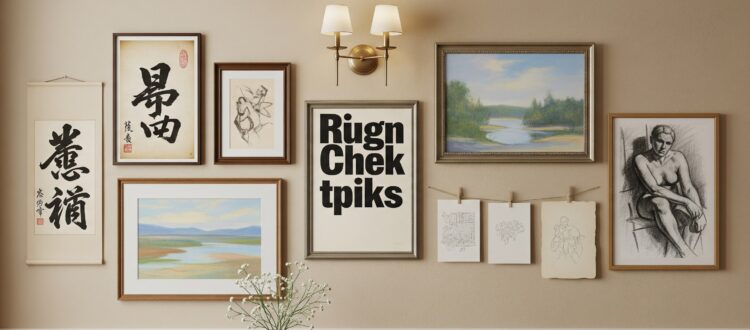The Art of Paper: A Guide to Paper Artworks
If there is one invention that has revolutionised the world, then that is the paper.
Before the invention of paper, people communicated through pictures and symbols. They used tree bark, papyrus, and clay tablets to carve these symbols. Not only were they bulky and inconvenient, but they were also not available to the common man easily.
Then, with the invention of paper in China, it became the most used medium for art.
From the beautiful dance of ink on paper in Calligraphy, to the bold statement made by printmaking, to the lights and shadows of Charcoal sketches, paper artworks have carved out a special niche in the world of art.
Works on paper is a broad term that indicates artwork that uses paper. Paper art offers a unique blend of accessibility and an inherent ability to capture the raw essence of what the artist is trying to convey.
Painting with pastels, ink, or charcoal, as well as prints and collages, are all included in the term paer works.
What is Paper Art?
Paper art is that art where an artist uses paper as a medium to convey their thoughts, feelings and beliefs.
It can include everything from simple paper cutting, Origami, three-dimensional sculptures, to sketches and paintings.
Also Read: Art Media: From Oil to Digital
The Humble Paper: Foundation For Creativity
Paper artworks are increasingly popular because of their versatility. Paper offers artists various forms of expression, from delicate drawings to impressive sculptural works.
Unveiling the Types of Paper Artworks
The beauty of paper as an art medium lies in the fact that it acts as a medium for a multitude of techniques, expressions and designs.
- Illustrations and Drawings

From the dawn of civilization, human beings have conveyed their thoughts and beliefs through illustrations. From the cave paintings of ancient times, to illustrated manuscripts of the medieval ages, to printmaking, these drawings have captured the culture and history of our past and continue to do so now.
- Pencil Drawings
The simplest yet most profound form of paper art. From graphite to coloured pencils, artists can achieve incredible detail, shading, and texture.
- Charcoal
Charcoal is one of the oldest art materials! Charcoal is made from burning wood, usually willow.
Charcoal helps artists to create dark, dense lines, but they can also be smudged in places to create a light and shadow effect.
One of the first artists to utilize charcoal as a primary medium was Albrecht Durer, who created charcoal portraits.
- Pastels
Prized for its brilliant colour, pastel was first used in the sixteenth century, notably by Leonardo da Vinci. Pastel is fabricated from one or several finely ground pigments, then rolled into sticks of coloured powder. Pastel is usually drawn on paper, which must have a slight texture or “tooth” to grab and hold the medium on its surface.
- Ink Drawings
Ink, a water-based medium made has been used to create drawings dating back to early civilizations like ancient Greece. However, it was the Chinese who really developed ink art, specializing in calligraphy and painting.
- Painting: Beyond the Canvas
While canvas is often associated with painting, paper offers a vibrant and accessible alternative for a wide range of paint mediums.
- Watercolour
Perhaps the most iconic paper-based painting medium. Prized for the luminosity of its transparent colours, watercolour is a water-based medium that is applied by brush, typically to white paper. Watercolour paintings, drawings, and other artworks are some of the oldest forms of art.
- Gouache
An opaque watercolour, gouache offers rich, matte colours and can be layered and blended beautifully on paper.
- Acrylics and Oils (on paper)

Young Woman at the Window, Salvador Dali, Oil on Paper
While less common than on canvas, both acrylic and oil paints can be successfully applied to specially prepared heavyweight paper.
- Calligraphy and Lettering: The Art of Beautiful Writing
Calligraphy, the art of beautiful handwriting, is an ancient and revered practice where paper plays a pivotal role.
Calligraphy artworks, using the best paper and ink, elevate the written word to the level of any other art form.
- Traditional Calligraphy: Using dip pens, brushes, and specialized inks, calligraphers create stunning compositions where each letter is a miniature work of art.
- Modern Lettering: While often more illustrative and less bound by strict rules, modern lettering also relies on the quality of paper to achieve clean lines and vibrant colours with markers, brush pens, and even watercolours.
- Printmaking
Printmaking encompasses a variety of techniques that involve transferring an image from a matrix (like a carved block or etched plate) onto paper. Paper’s ability to pick up fine details and hold ink is essential to this art form.
- Woodcut and Linocut: Raised relief prints where areas are carved away from a block, and the remaining raised surface is inked and pressed onto paper.
- Etching and Engraving: Intaglio prints where lines are incised into a metal plate, inked, and then pressed onto damp paper, which picks up the ink from the incised lines.
- Screen Printing (Serigraphy): Ink is pushed through a mesh stencil onto paper, allowing for bold colours and graphic designs.
- Lithography: A planographic process where an image is drawn onto a stone or metal plate with an oily medium, and then ink adheres only to the oily parts, transferring to paper.
- Paper Sculpture and Three-Dimensional Art

Beyond two-dimensional surfaces, paper can be manipulated into intricate three-dimensional forms, transforming it from a flat sheet into a sculptural masterpiece.
- Origami: The ancient Japanese art of paper folding, creating complex figures without cutting or glueing.
- Paper Cutting: Delicately cut patterns and scenes, often symmetrical, creating intricate lacework designs.
- Quilling (Paper Filigree): Rolled and shaped strips of paper glued together to create decorative designs.
- Mixed Media
Unlike other art forms, paper artworks can be crafted using mixed media.
For example, ink and graphite can be combined to create one image.
Some types of paint, like gouache and watercolour, can also be used and combined with other media on paper.
The Right Paper for the Right Art: A Crucial Choice
Just as a painter selects specific brushes, an artist working with paper chooses their surface with care.
Before delving into the types of paper, let’s understand GSM.
GSM in paper stands for “grams per square meter,” which is the standard unit used to measure the weight or thickness of paper.
- Drawing Paper (90-130 gsm)
Drawing paper is the most versatile option for a variety of media, from pencils to ink and more. Drawing papers are available in different textures and varying smoothness to suit every artist’s needs.
- Watercolour Paper (140-300 gsm and up)
The important consideration for this paper is that it is heavy. This paper is designed to absorb large amounts of water without buckling. It comes in hot-pressed (smooth), cold-pressed (medium texture), and rough (heavily textured) finishes, each yielding different effects.
- Calligraphy Paper
Smooth, often sized (treated to reduce absorbency), to prevent ink from bleeding and allow for crisp lines.
- Printmaking Paper
Varies widely depending on the technique. It’s often strong, absorbent, and made from cotton or other fibers for durability.
- Pastel Paper
Features a distinct “tooth” or texture (sometimes even a sanded surface) to hold the powdery pigments of pastels effectively.
- Mixed Media Paper
A versatile, heavier paper designed to withstand various wet and dry mediums, often with a balanced absorbency.
Why Paper Art Endures: A Timeless Appeal
In an age of fleeting digital images, art on paper continues to captivate and enchant collectors and artists alike.
- Tactile Connection: There’s an undeniable sensory pleasure in interacting with paper art.
- Authenticity: There is a certain level of intimacy and authenticity. Paper has been the oldest medium for conveying thoughts and ideas. Bringing that as an artwork and giving it life is like going back to our roots.
- Accessibility and Affordability: Compared to large-scale paintings or sculptures, paper art is often more accessible to emerging collectors and artists.
Giftex: A World Of Collectibles Auction
We at Giftex are thrilled to announce our upcoming online auction, featuring paper work art by new and established artists. This auction will be dedicated to the timeless and versatile medium of paper art. This highly anticipated event will take place on September 15th and 16th, 2025.
Don’t miss this extraordinary opportunity to explore and bid on some of the finest paper artwork available.
Paper: A Medium of Endless Possibilities
From the ephemeral beauty of a charcoal sketch to the intricate magic of a calligraphy work, paper artworks are enduring.
In this digital age, paper still plays a significant role as an artistic medium.
Investing in paper art is not just acquiring a decorative item; it’s bringing a piece of profound artistic expression into your home, enriching your space with its quiet strength and captivating charm.






